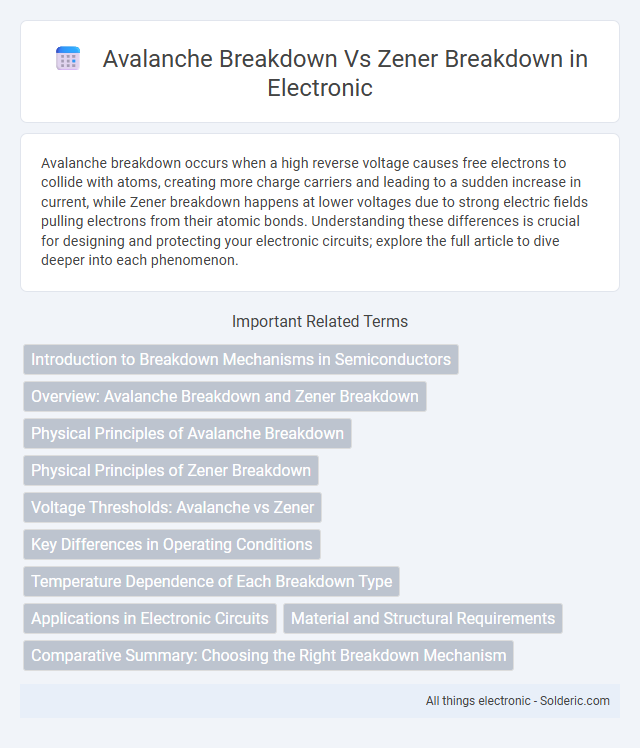Avalanche breakdown occurs when a high reverse voltage causes free electrons to collide with atoms, creating more charge carriers and leading to a sudden increase in current, while Zener breakdown happens at lower voltages due to strong electric fields pulling electrons from their atomic bonds. Understanding these differences is crucial for designing and protecting your electronic circuits; explore the full article to dive deeper into each phenomenon.
Comparison Table
| Feature | Avalanche Breakdown | Zener Breakdown |
|---|---|---|
| Cause | Carrier multiplication due to high electric field | Quantum mechanical tunneling under strong electric field |
| Voltage Range | Typically above 6 V | Typically below 6 V |
| Mechanism | Impact ionization causing carrier avalanche | Electron tunneling through narrow depletion region |
| Temperature Dependence | Breakdown voltage increases with temperature | Breakdown voltage decreases with temperature |
| Region of Occurrence | Reverse biased p-n junction with thick depletion layer | Reverse biased p-n junction with thin depletion layer |
| Applications | Overvoltage protection, high voltage diodes | Voltage regulation, reference voltage devices (Zener diodes) |
Introduction to Breakdown Mechanisms in Semiconductors
Avalanche breakdown occurs in semiconductors when a high reverse voltage accelerates free electrons to collide with the lattice atoms, creating electron-hole pairs and leading to a chain reaction of charge carriers. Zener breakdown happens at lower reverse voltages due to strong electric fields causing quantum tunneling of electrons across the depletion region. Both mechanisms cause a sudden increase in current, but Avalanche breakdown is dominated by impact ionization, while Zener breakdown is governed by tunneling effects.
Overview: Avalanche Breakdown and Zener Breakdown
Avalanche breakdown occurs when a high reverse voltage causes free electrons to gain enough energy to ionize atoms, creating a chain reaction of current multiplication, typically in diodes with a wide depletion region. Zener breakdown happens at lower reverse voltages in heavily doped diodes, where a strong electric field induces quantum tunneling of electrons across a narrow depletion layer. Your choice between these mechanisms depends on the voltage rating and doping concentration tailored to specific electronic applications.
Physical Principles of Avalanche Breakdown
Avalanche breakdown occurs when the reverse voltage across a semiconductor junction becomes so high that it accelerates free electrons to energies sufficient to collide with lattice atoms, generating additional electron-hole pairs through impact ionization. This chain reaction leads to a sudden increase in current, causing the device to conduct in reverse without damage up to a certain limit. Understanding the physical principles of avalanche breakdown helps you select appropriate diodes for high-voltage applications where controlled breakdown is essential.
Physical Principles of Zener Breakdown
Zener breakdown occurs when a strong electric field enables electrons to tunnel through the depletion region of a semiconductor junction, typically at low reverse voltages around 5-6 volts. This quantum mechanical tunneling effect takes place in heavily doped p-n junctions, resulting in a sharp and controlled breakdown with minimal noise. Your electronic circuits benefit from Zener breakdown in voltage regulation due to its predictable voltage threshold and stability under reverse bias conditions.
Voltage Thresholds: Avalanche vs Zener
Avalanche breakdown occurs at higher voltage thresholds typically above 6 volts where the semiconductor's depletion region widens and carriers gain enough energy to create electron-hole pairs, leading to a sudden increase in current. Zener breakdown happens at lower voltage thresholds, often below 6 volts, due to quantum mechanical tunneling through a thin depletion layer in heavily doped p-n junctions. The precise voltage at which each breakdown occurs depends on doping concentrations and semiconductor material properties, making Avalanche suitable for high-voltage protection and Zener ideal for voltage regulation at low voltages.
Key Differences in Operating Conditions
Avalanche breakdown occurs at higher reverse voltages when carriers gain enough energy to create electron-hole pairs through impact ionization, typically in lightly doped PN junctions. Zener breakdown takes place at lower reverse voltages in heavily doped junctions where the strong electric field allows quantum tunneling of electrons across the depletion region. Your selection between these mechanisms depends on the voltage range and doping concentration suitable for specific voltage regulation or protection applications.
Temperature Dependence of Each Breakdown Type
Avalanche breakdown exhibits a positive temperature coefficient, meaning the breakdown voltage increases with rising temperature due to enhanced carrier scattering and reduced mean free path. In contrast, Zener breakdown shows a negative temperature coefficient as the breakdown voltage decreases with increasing temperature because of the enhanced tunneling probability across a narrower energy bandgap. Understanding these temperature dependencies is crucial for designing voltage regulation circuits and ensuring reliability in semiconductor devices operating under varying thermal conditions.
Applications in Electronic Circuits
Avalanche breakdown is commonly used in high-voltage protection circuits, where devices must safely handle surges by rapidly increasing current without damage. Zener breakdown finds application in voltage regulation, providing a stable reference voltage in power supplies and signal conditioning. Your circuit design benefits from choosing avalanche for transient suppression and Zener for precise voltage control.
Material and Structural Requirements
Avalanche breakdown occurs primarily in lightly doped semiconductor regions with a wide depletion zone, enabling high electric fields to accelerate carriers and cause impact ionization. Zener breakdown takes place in heavily doped, narrow depletion regions where electron tunneling dominates due to strong electric fields. Material purity, doping concentration, and junction width are critical factors differentiating the structural requirements for avalanche and Zener breakdown mechanisms.
Comparative Summary: Choosing the Right Breakdown Mechanism
Avalanche breakdown occurs when carriers gain enough kinetic energy to create electron-hole pairs through impact ionization, suitable for high-voltage, low-current applications due to its gradual, non-destructive conduction onset. Zener breakdown results from quantum tunneling in highly doped p-n junctions at low voltages, providing precise voltage regulation with sharp voltage clamping behavior ideal for low-voltage, precision reference circuits. Selecting between these mechanisms depends on application voltage range, current requirements, and circuit stability, with avalanche favored in power protection and Zener in voltage regulation contexts.
Avalanche breakdown vs Zener breakdown Infographic

 solderic.com
solderic.com